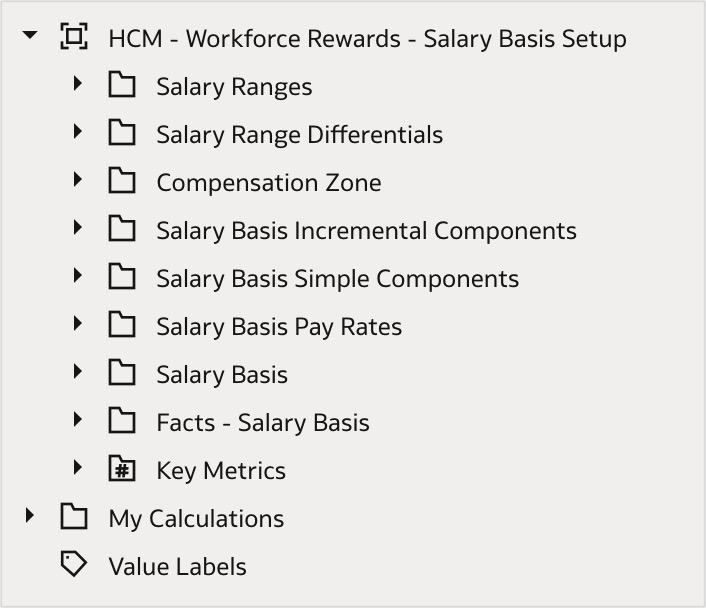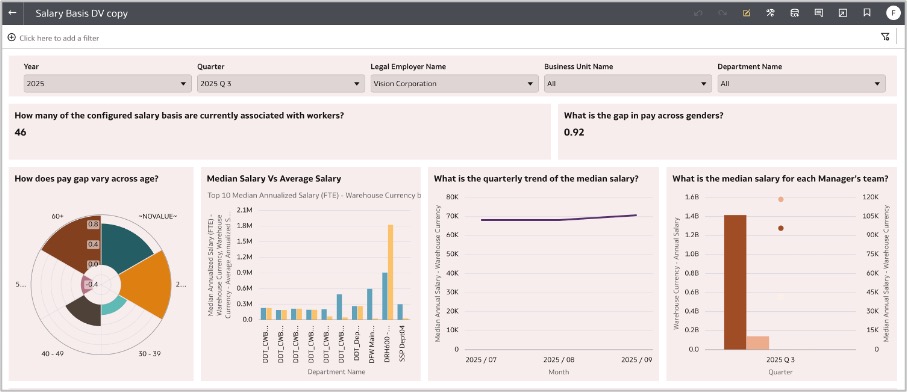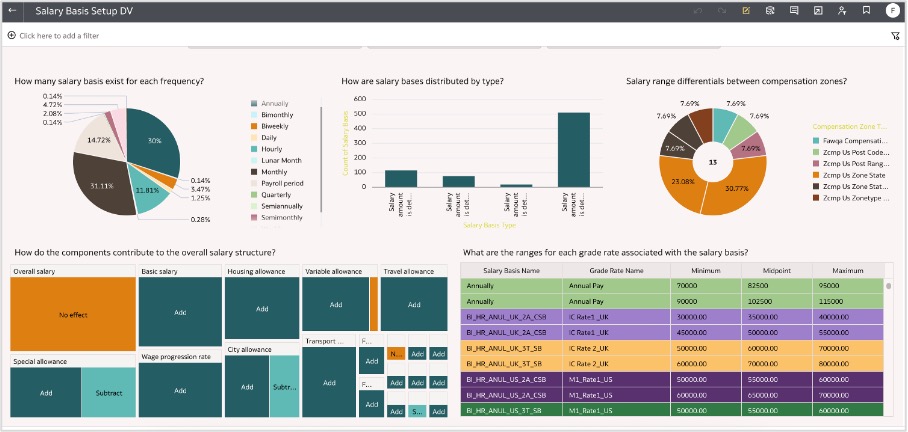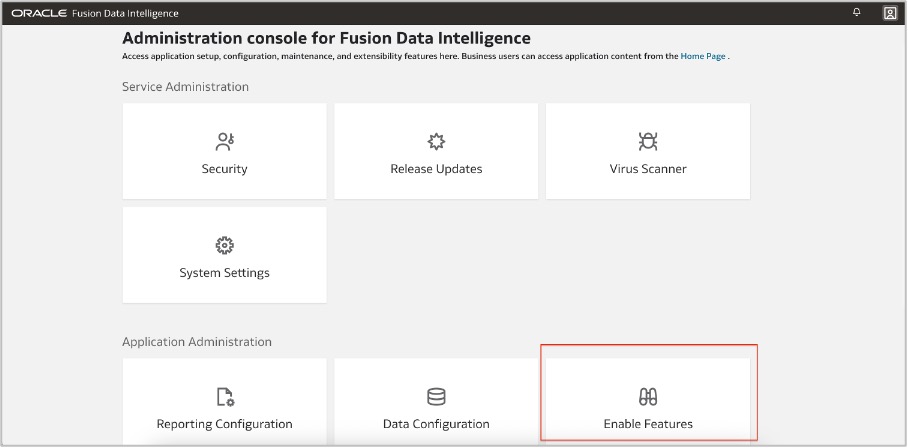Key attributes like frequency, annualization factor, salary amounts, and grade rate ranges form the foundation of compensation insights. To truly understand salary structures, it’s important to look closely at the components that makeup the salary basis, particularly those driving the greatest impact on overall compensation costs. These components help identify the timing and structure of worker pay, providing a valuable view of the organization’s total compensation picture.
New KPIs and dimensions have been added to the HCM – Workforce Rewards – Salary Basis subject area.
New KPIs
- Unadjusted Pay Gap
- Count of Salary Basis (associated with worker)
- Median Salary Amount
- Median Annual Salary
- Median Annualized Salary (FTE)
New dimensions
- Worker – Salary Range Differentials
- Worker – Compensation Zones
- Incremental Components
- Simple Components
- Salary Basis Pay Rates
There’s also a new subject area dedicated to the setup information, HCM – Workforce Rewards – Salary Basis Setup.
Additionally, a comprehensive analysis of salary basis is incomplete without visibility into the components that define its configuration. To support this, we are introducing a dedicated subject area for salary basis configuration, HCM – Workforce Rewards – Salary Basis Setup, which brings together all relevant dimensions and facts related to salary basis configuration.

What business user challenges are addressed by these updates?
1. HCM – Workforce Rewards – Salary Basis
- How can users monitor and manage unused salary basis configurations?
By leveraging these new enhancements, users can now access information on the total number of configured salary basis records, along with how many are actively assigned to workers. This helps identify salary basis setups that exist in the system but remain unused, enabling better configuration management.
- How can organizations identify potential pay disparities?
The new Unadjusted Pay Gap KPI helps in the early identification of potential pay disparities, helping promote fairness and compliance across the workforce. The pay gap can also be plotted against various attributes like age, ethnicity, and more.
- What insights can median salary provide?
With the introduction of the newest KPIs such as median salaries, it’s now easier to compare the average salary with the median salaries across various organizational levels, such as business unit (BU), legal employer (LE), or department level. A quarterly trend analysis of median salaries further enhances visibility into how compensation metrics evolve over time.
While average salary figures can be skewed by outliers, especially when teams with exceptionally high or low salaries. In contrast, median salary offers a more balanced view of central compensation trends, as it’s less affected by extreme values. With these enhancements, users can now identify the median salary for a specific BU or LE and assess whether teams are compensated above or below that benchmark. This allows for targeted attention where discrepancies are significant, supporting fair and data-driven compensation decisions. Moreover, the median salary can be analyzed across multiple parameters, such as job, grade, and more, offering flexible and meaningful insights into pay equity.
- How to achieve detailed cost analysis and informed compensation planning?
In addition to salary level insights, the newly introduced component level visibility allows organizations to better understand how each compensation component is utilized and the proportion it contributes to overall organizational cost, enabling more granular cost analysis and strategic planning.

2. HCM – Workforce Rewards – Salary Basis Setup
- How can organizations align pay structures with geographic and market factors?
Detailed information on salary ranges allows organizations to understand the defined pay limits for each salary basis. The inclusion of salary range differentials supports adjustments based on geographic or market-specific factors. Compensation zones are also captured, enabling grouping of locations under a unified pay structure.
- What components constitute the salary basis structure?
This subject area covers both simple and incremental components, offering insight into how different elements contribute to overall compensation. It also supports analysis of pay rate-based salary basis configurations, and provides key metrics that reflect the number of salary basis records categorized by salary basis type, enabling a more granular understanding of pay structure and cost distribution.
- How to analyze the salary basis configuration?
The enhancements include insights into the number of salary basis records configured by frequency and salary basis type, the distribution across compensation zones, and the salary ranges defined for each salary basis.

Security Overview
1. HCM – Workforce Rewards – Salary Basis
It’s important to note that these enhancements don’t affect existing security configurations. All current security settings remain unchanged.
How do I access the new dimensions related to components?
These enhanced dimensions become available once the associated functional area, Salary Basis Snapshots, is activated under Preview Features.
- In Oracle Fusion Data Intellignece (FDI), navigate to the Administration console, and click Enable Features.

- On the Preview Features tab, under Functional Areas, toggle the Salary Basis Snapshots feature to On.

2. HCM – Workforce Rewards – Salary Basis Setup
To access this subject area, you must assign the duty role, OA4F_HCM_SALARY_BASIS_SETUP_ANALYSIS_DUTY.
What changes should you expect?
As part of this enhancement, there are structural dimensions updates to improve consistency. Some existing dimensions will be either relocated or decommissioned, as outlined below:
- Salary Ranges: This dimension is now available in the newly introduced subject area dedicated to salary basis setup, HCM – Workforce Rewards – Salary Basis Setup.
- Worker Salary Component Details: Attributes from this dimension are moved to the Incremental Components dimension within the same subject area.
- Facts – Worker Salary Component: The KPIs previously found here are now available under the facts folder of the Incremental Components dimension within the same subject area
Conclusion
By introducing the new KPIs, organizations will now have the ability to view median salaries – less affected by outliers than averages, helps identify pay inequities more effective across BU, LE, or departments. Furthermore, the addition of component-level insights provides a detailed view of how each compensation element contributes to overall costs, supporting more precise cost analysis and strategic workforce planning.
- If you have any questions, post them in the Fusion HCM Analytics community forum.
- For more information about Oracle Fusion HCM Analytics, check out the Oracle Help Center documentation.
- Follow us on Twitter@OracleAnalytics, and connect with us on LinkedIn.

